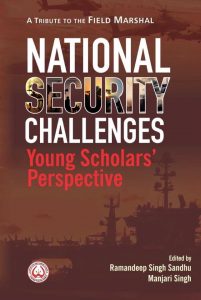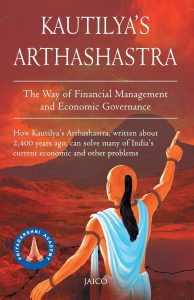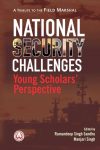
“We cannot continue to rely only on our military to achieve national security objectives that we have set. We have got to have a civilian national security force that is just as powerful, just as strong and just as well funded” – Barack Obama
Barack Obama’s words of wisdom on the aspect of applicability and accountability towards national security is true to its last word. National security, as it stands today, is not only about securing the boundaries of a nation against aggressive and inimical state and non-state actors but also about a holistic whole of the government approach through a systems methodology which allows for the delivery of an integrated, synchronised and highly effective security umbrella to a nation. Such an approach requires long-term vision supported by a strategic thought process which runs in the veins of each arm of the government. In a democratic nation like India where the basic principle of governance is governed by the concept of a government of the people, by the people and for the people, the culture of strategic thought process which aims at achieving our national security objectives has to permeate through every citizen of the nation.
Cultural Connect

As rightly brought out by National Security Adviser Ajit Doval in his message for the book, India’s historical and revered epics like Ramayana and Mahabharata provide lessons on Rajniti, Yudhniti and governance and treatises like Kautilya’s Arthashastra, Thiruvalluvar’s Thirukkural and Kamundaki’s Nitisara contain important tenets of Indian strategic thought. Therefore, there is a strong cultural and historical connect with strategic thinking in India which in those days was embedded in the education system. The more than 200 years of British Rule and subjugation of our ancient education system and its overwriting by the British education system eroded the culture of the strategic way of thinking and diluted the perspectives on national security among Indians.
While the British continued to expand, protect and rule the subcontinent based on strategic thinking and application, they did not let this thought process develop among the local population. This is apparent from the fact that many of our early post-independence national leaders despite their great leadership and political skills failed to foresee the issues of then boundary disputes which quickly raised their heads and have since then kept our national development in undue check. Exceptional strategic thinkers like Sardar Patel were far and few in those times who did manage to induce visionary strategic thinking on National Security in those times, but it was not enough to prevent our nation from getting embroiled in a multitude of security problems.
Refreshing & Reassuring
Over 73 years since our independence we have grappled with increasingly complex situations which have challenged our national security, the latest being the Chinese incursions and the subsequent clash at Galwan leading to the death of 20 brave Indian soldiers and a tense military standoff which will have far-reaching consequences both militarily and economically.
In this context, this book on National Security Challenges: Young Scholars’ Perspective” (edited by Col Ramandeep Singh Sandhu and Dr. Manjari Singh) is refreshing and reassuring at the same time. Refreshing because it brings out perspectives on national security through the prism of preserving cultural identity as a means of strengthening national security, discusses national security challenges and India’s response to it through the four realistic tenets of deterrence, security dilemma, the balance of power and interests defined in terms of power and also scans the technological imperatives in the field on cyberspace, space and intelligence that need to be focused on by our nation to meet its national security challenges.
The book is also reassuring because each of these essays written and compiled in this book is from young scholars, researchers and students from universities and colleges across India, thus implying that our future generation is very much aligned and in sync with the challenges our nation faces in these volatile and uncertain times and also has the requisite thought process to foresee implications and suggest remedies to overcome them.
The book is a collection of 12 award-winning essays from an all-India University level competition held in memory of Field Marshal SHFJ Manekshaw under the aegis of Centre for Land Warfare Studies (CLAWS). An overwhelming number of students from several universities across the country participated and contributed their perspectives on various aspects of national security. The 12 selected essays are systematically grouped under three different themes i.e. Conceptual Understandings and Facets of India’s National Security; Technological Evolution, Cyber Threats and Security; and National, Regional and Global Experiences. Each of these themes has four essays which provide a well-rounded understanding of the topic it is meant to explain. The themes are well chosen and give a clear understanding of the main topic of national security challenges in a flow that keeps the reader enthralled and interested.
Counter-narrative
The first chapter by Siddanth Tomar is unique writing on how the cultural identity of the nation is an important security asset, reasons why it is under threat and challenges thereof. It correctly identifies the need to create a counter-narrative which projects the true picture of our historical values and can raise wisdom, by developing analytical faculties in masses, which will enable them to distinguish between information and propaganda and thereby developing pride in their past. The idea of documenting a comprehensive National Security Strategy is put forth by Priyanka Patel in her chapter titled “India’s National Security Strategy: An Idea Whose Time Has Come”. She conclusively argues that a well documented National Security Strategy is required to ensure that National Security Objectives are clearly defined in line with the emerging threats and situations and can become a base for directives to each arm of the government to align their policies towards the achievement of those objectives irrespective of which government is in power. The need for such a document is discussed giving examples of similar documented strategies of US, Russia, China and Israel. It is interesting to note the similarities of national security challenges faced due to unresolved boundary disputes and aggressive neighbours of Israel and its laid down perspective and strategy in Israel’s document authored by Ben Gurion. Comprehensive National Power can only flow if a well envisaged and documented National Security Strategy is in place as it allows long term policies to be framed and implemented to gain leverage against security challenges facing a nation.
The Way Ahead
The theme of “Technological Evolution, Cyber Threats and Security” is apt in the present world order where technology has permeated our way of life and thus presents a clear threat to privacy, information and various services which provide basic requirements to a citizen. A threat to such an all-encompassing and valuable resource can have huge implications for national security. Thus, the four chapters under this theme clearly bring out the various threats to resources in cyberspace, space and intelligence domains and measures to mitigate the same. Space as a frontier for security is now being actively discussed and understood at the National level. In the backdrop of offensive capabilities demonstrated by India in terms of a successful test of Anti-Satellite Missile, an understanding of our vision for utilisation of space for securing our national interests among the citizens is a must.
The last theme of the book on “National, Regional and Global Experiences” take an in-depth look at the regional boundary disputes of India and its responses in reaching out to its neighbours through its “Neighbour’s First Policy”, counter- insurgency operations in J&K, Indo-Vietnam relations and how the US and China view national security.
A chapter on how China resolved its boundary disputes with most of its neighbours through a long-term engagement and strategic posturing would have been ideal under this theme and would have given the reader a comprehensive understanding of how national will and strategic thought can overcome major security challenges especially those which emanate from boundary disputes. On the global front, an addition of an essay on the emerging new world order and India’s role in the Quad and its increasing importance in the present scenario would have kept the book up to date with the emerging global trends. However, keeping in mind that the book is a collection of essays written for a competition which took place during the period between 2018- 2019, a year before the uncertain gloom of the COVID-19 pandemic and the Chinese incursions in Galwan valley was thrust on to our nation and the world deeply jolting the world order, the missing links are acceptable.
The book provides a comprehensive view of national security challenges from young impressionable minds, which brings to fore that information accessibility due to the advent of the internet and social media is making the future generations well-read on strategic affairs, highly analytical and capable of visionary thinking. This is certainly reassuring and augurs well for India’s quest for regional power status. A must-read for all citizens of the nation.

Col. Ranjan Prabhu was commissioned into the Regiment of Artillery in 1998. An alumni of NDA, Khadakwasla, and DIAT, Pune, he has commanded his Regiment in an operational environment. An avid writer and defence analyst, he has contributed on innovative concepts in Military Journals of national repute. He has been an Instructor Gunnery in School of Artillery, Devlali.
Book: Ramandeep Singh Sandhu and Manjari Singh (eds) (2020). National Security Challenges: Young Scholars’ Perspective. CLAWS/Pentagon Publishers LLP. ISBN: 978-93-90095-04-9. Hardback.
Disclaimer: The views expressed and suggestions made in the review are solely of the author in his personal capacity and do not have any official endorsement. Attributability of the contents lies purely with the author.




